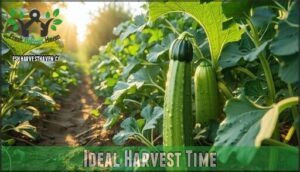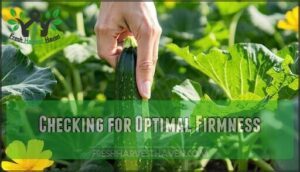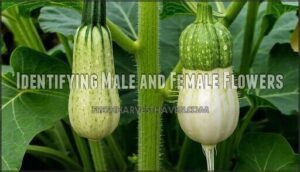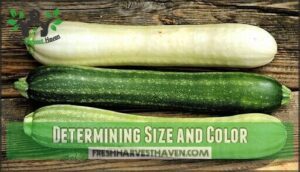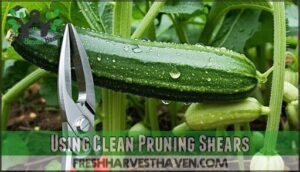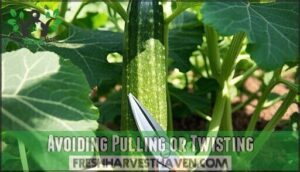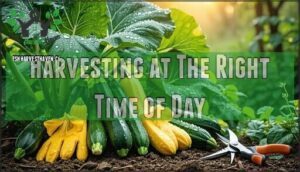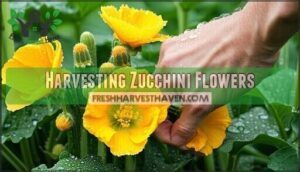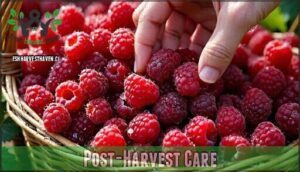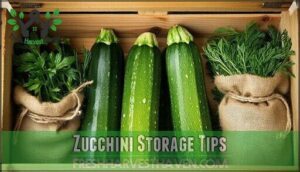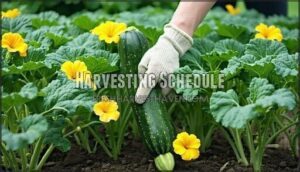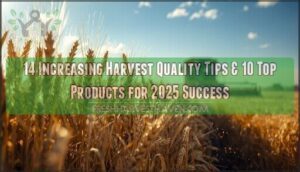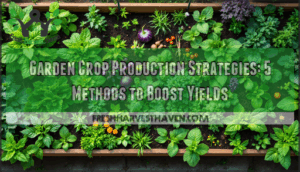This site is supported by our readers. We may earn a commission, at no cost to you, if you purchase through links.
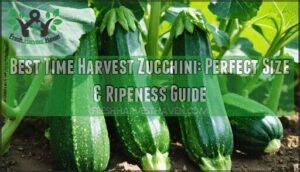 You’re wondering when’s the best time to harvest zucchini. Typically, it’s 45-55 days after planting, when they’re about 6 inches long.
You’re wondering when’s the best time to harvest zucchini. Typically, it’s 45-55 days after planting, when they’re about 6 inches long.
You’ll know they’re ready when they’re firm, but not hard, and the skin is tender. Check for ideal size and color, usually a deep green.
Harvesting at the right time guarantees peak flavor and texture. Now that you know when to harvest, you’re probably curious about how to do it without damaging the plant – and what to do with all that zucchini once you’ve picked it, to enjoy its best taste.
Table Of Contents
- Key Takeaways
- Zucchini Plant Characteristics
- Ideal Harvest Time
- Inspecting Zucchini
- Harvesting Techniques
- Harvesting Zucchini Flowers
- Post-Harvest Care
- Maximizing Zucchini Yield
- Zucchini Storage Tips
- Harvesting Schedule
- Frequently Asked Questions (FAQs)
- When to harvest zucchini?
- When is the best time to pick zucchini?
- Does harvest time affect the taste of zucchini?
- How often should you pick zucchini?
- Can you harvest small zucchini?
- When should I plant zucchini?
- What month is zucchini ready?
- How to tell when a zucchini is ready to pick?
- What happens if you leave zucchini on the vine too long?
- What time of year is zucchini harvested?
- Conclusion
Key Takeaways
- You’ll know it’s time to harvest zucchini when they’re 6-8 inches long, typically 45-55 days after planting, and still tender – so keep an eye on their size and texture.
- Harvesting at the right time is crucial, as it affects the taste of zucchini – you don’t want to end up with bitter and stringy ones, so pick them when they’re ready.
- You should pick zucchini every 1-2 days, or when it’s 6-8 inches long, to encourage continuous production and prevent overgrowth, which can lead to tough, stringy fruit.
- Don’t leave zucchini on the vine too long, or you’ll end up with tough, stringy ones – instead, check on them daily and harvest when they’re ready to get the best flavor and texture.
Zucchini Plant Characteristics
You’ll recognize zucchini as a vigorous summer squash that grows on bushy plants with large, silvery-streaked leaves that can hide developing fruit.
Vigorous summer squash grows on bushy plants with large leaves hiding developing fruit.
These prolific producers belong to the Cucurbita family and will reward your careful attention with multiple harvests throughout the growing season, making them a great choice for summer gardens.
Summer Squash Varieties
When choosing summer squash varieties, you’ll discover Heirloom Squashes like Black Beauty and Cocozelle offer Unique Flavors.
While modern hybrids provide Disease Resistance through Hybrid Vigor.
Each variety has distinct zucchini harvest time windows and Culinary Uses.
Whether you’re harvesting zucchini at 6 inches or when to pick zucchini depends on your chosen variety’s characteristics and intended kitchen applications.
Vigorous Growth and Requirements
Zucchini plants are growth machines that’ll surprise you with their rapid growth once conditions are right.
These summer squash powerhouses need specific care to reach their full potential and guarantee perfect zucchini harvest time.
Your plants demand three key elements for maximum zucchini growth:
- Full sunlight exposure – at least 6-8 hours daily for maximum energy production
- Rich, well-draining soil – mix in compost to boost nutrient needs and soil health
- Consistent watering schedule – deep watering twice weekly prevents stress and maintains steady development
When you nail these sunlight requirements and watering basics, you’re setting up ideal conditions for harvesting zucchini at peak quality.
Edible Skin and Multiple Harvests
The tender skin of young zucchini offers incredible versatility—you’ll harvest frequently for continuous production throughout the growing season.
Regular harvesting timing at ideal size guarantees second harvests keep coming.
When you’re harvesting zucchini, focus on skin benefits like smooth texture and vibrant color.
| Best Size | Skin Condition |
|---|---|
| 5–8 inches | Smooth, firm |
| 2–3 inches (pattypan) | Tender, light sheen |
| Round: Tennis ball | Evenly colored |
| Large flowers | Near-perfect timing |
| Skin Benefits | Visible freshness |
Ideal Harvest Time
Timing your zucchini harvest correctly makes the difference between tender, flavorful squash and tough, bitter disappointments that belong in the compost bin.
Harvest zucchini at the right moment for tender, flavorful squash.
You’ll want to catch these fast-growing vegetables at their sweet spot—typically 6 to 8 inches long—before they turn into baseball bats overnight, which is a critical moment to ensure they remain tender.
Factors Affecting Maturity
Several factors influence when your zucchini reaches perfect maturity for harvesting.
Soil nutrients provide the foundation—rich, well-composted soil accelerates growth while poor conditions delay development. Sunlight exposure matters tremendously; plants need six to eight hours daily for ideal fruit production.
Consistent watering practices keep growth steady, while temperature fluctuations can speed or slow ripening.
Finally, pollination success determines whether flowers develop into harvestable fruit, making these environmental conditions vital for zucchini harvest timing.
Harvesting usually starts after the flowering begins around 50-60 days after planting.
Signs of Readiness
Skin Texture reveals readiness—smooth, glossy surfaces indicate perfect zucchini harvest timing, while dull or wrinkled skin suggests overripeness.
Size Matters: ideal length measures 6-8 inches for most varieties.
Color Intensity should appear vibrant green, yellow, or white depending on your cultivar.
Blossom Condition at the tip stays fresh, not brown or shriveled.
Stem Appearance remains firm and green when you’re identifying ripe zucchini properly.
Harvesting at Peak Flavor
You’ll capture optimal ripeness when zucchini reach 6-8 inches long with firm, glossy skin.
Flavor indicators include tender flesh and small seeds – texture changes dramatically once fruits exceed this size.
Taste differences become noticeable as overripe zucchini develop stringy, bitter flesh.
Check your zucchini harvest daily since harvesting frequency directly impacts flavor quality.
Harvesting summer squash at peak zucchini size guarantees the best zucchini taste.
Identifying ripe zucchini becomes easier with practice – morning inspections work best when plants are hydrated.
Morning harvests are ideal because they maximize nutrient content.
Inspecting Zucchini
When you inspect zucchini, you’ll want to check for firm texture, vibrant color, and the right size—ideally before it hides under a leaf and grows into a baseball bat overnight.
Pay close attention to the flowers too, since knowing the difference between male and female blooms helps you predict which fruit will be ready next.
Checking for Optimal Firmness
Anyone who’s handled zucchini knows firmness is your secret handshake for ripeness.
Give the squash a gentle squeeze—you’re looking for ideal density, not a mushy handshake.
Firm skin signals it’s time for a zucchini harvest, while Soft Spots or an Overripe Texture mean you’ve missed the sweet spot.
Underripe feel? Wait a bit.
For harvesting summer squash, fruit firmness and size matter—pick when it’s tender-crisp, not rubbery or rock-hard.
Identifying Male and Female Flowers
After checking firmness, turn your attention to zucchini flower morphology. Zucchini plants are monoecious—meaning you’ll spot both male and female flowers on the same plant.
Here’s how you can tell them apart:
- Male flowers: Long, thin stems, single stamen loaded with pollen.
- Female flowers: Short, thick stems with a tiny “mini-zucchini” at the base, multi-lobed stigma.
- Both blossoms are edible—try them stuffed or fried!
Only the female flowers, identifiable by their distinct ovary structure, will develop into zucchinis. Accurate identification boosts pollination success and keeps your garden’s fruiting flowers thriving.
Determining Size and Color
After spotting male and female flowers, focus on zucchini size and color.
The ideal length is 6-8 inches—think of a dollar bill for easy reference.
Color indicators matter: deep green, yellow, or white, depending on variety differences.
Smooth, glossy skin texture signals peak ripeness.
Ignore hidden giants; oversized zucchini often means tough skin and advanced seed development.
| Size | Color | Skin Texture |
|---|---|---|
| 6-8 in | Deep Green | Smooth, Glossy |
| 8-12 in | Pale Yellow | Firm, Slightly Dull |
| 12+ in | Mottled White | Thick, Rough |
Harvesting Techniques
When it’s time to harvest zucchini, you’ll want to use sharp, clean pruning shears and avoid the urge to twist or yank the fruit from the stem.
Early morning is best for picking, since the plants are full of moisture—plus, you’ll beat your neighbor to the best squash.
Using Clean Pruning Shears
Once you’ve inspected your zucchini for firmness and ripeness, reach for your sterilized garden shears—sharpness matters! Using clean pruning shears at the proper angle means you’ll prevent disease and avoid damage to the plant. Think of it as giving your zucchini a fresh haircut, not a wrestling match.
For best results:
- Wipe blades with alcohol before each use
- Sharpen monthly for a clean cut
- Cut stems 1–2 inches from the fruit
- Store tools dry to prevent rust
Using quality cutting implements is essential for a healthy harvest. Your zucchini harvest will thank you!
Avoiding Pulling or Twisting
Harvesting zucchini should feel more like surgery than a wrestling match.
Skip pulling or twisting—those moves invite stem damage, plant stress, and fruit breakage.
For bruise prevention and clean cuts, use sharp pruning shears or a knife.
This precise cutting technique keeps your plant thriving, reduces bruising, and guarantees you’re ready for the next zucchini harvest.
Remember, gentle hands mean more harvests and healthier plants.
Harvesting at The Right Time of Day
If you want ideal freshness and perfect texture, aim for a zucchini harvest in the early morning—plants are plump with moisture, and dew impact is minimal.
Evening works too, once the heat effects fade. Avoid midday, when plant moisture drops and limp results sneak in.
Morning harvesting also helps capture peak flavor.
For best harvesting techniques, remember:
- Morning vs. Evening
- Avoid midday
- Daily checks
- Target harvestable fruit
Harvesting Zucchini Flowers
You can pick zucchini flowers for cooking or pollination, but timing and technique matter if you want your plants to keep producing.
Harvest male blooms early in the morning, when they’re open and dewy, and you’ll avoid the disappointment of wilted petals or a zucchini shortage later—nobody wants to explain missing squash at dinner, which can be a result of poor technique.
Edible Male and Female Flowers
A zucchini patch gives you more than just squash—its edible blossoms are a chef’s secret weapon.
Male flowers are bigger and perfect for stuffing or frying, while female flowers, with baby zucchini attached, bring a delicate flavor.
For top Flower Taste and easy Flower Preparation, pick early, remove stamens or pistils, and enjoy Cooking Flowers fresh.
| Flower Type | Flower Taste | Preparation Tip |
|---|---|---|
| Male | Mild, sweet | Stamen Removal |
| Female | Tender, rich | Pistil Removal |
| Zucchini Blossom | Elegant, nutty | Quick sauté or fry |
Using Flowers as Pollinators
Speaking of edible blossoms, you can use male flowers for more than just garnish—they’re your secret weapon for flower pollination.
If bees seem lazy, try hand pollination. Here’s how:
- Pluck a fresh male flower and peel back the petals.
- Gently dab its pollen onto the sticky center of a female flower.
- Repeat with other female blossoms.
This manual pollination boosts fruit set, guarantees better yields, and helps when pollinator attraction falls short on cool mornings.
Picking Flowers at The Right Time
Every gardener knows timing is everything—especially with zucchini flowers. For peak Blossom Flavor and ideal Pollination Timing, pick flowers early in the morning when they’re wide open and pollen’s ready for action.
Male flowers on long stems are perfect for pollination or frying, while female blooms, with tiny zucchini attached, shine in the kitchen.
Skip wilted ones—they’re past their prime. Use clean Harvesting Methods, and store flowers gently to preserve Flower Edibility and freshness.
Post-Harvest Care
Once you’ve picked your zucchini, you’ll want to keep it fresh and crisp, not limp and soggy like forgotten leftovers.
Proper post-harvest care, including refrigeration, moisture control, and quick freezing, guarantees your harvest stays delicious—no science degree required, just a little attention to detail.
Refrigerating and Freezing Options
One surefire way to keep zucchini crisp is smart storage. For shortterm storage, tuck unwashed zucchini into perforated bags in your refrigerator’s crisper—expect peak freshness for up to a week (Refrigeration Duration).
For longterm storage, try these preservation methods:
- Slice and pre-freeze on a tray
- Seal slices in freezer bags
- Label for easy use
- Freeze promptly
- Avoid overpacking for Quality Maintenance
Freezing Methods matter!
Blanching and Shocking Techniques
Ever wondered why chefs swear by blanching before freezing zucchini? It’s all about enzyme inactivation, color preservation, and keeping that signature texture impact.
After boiling slices for 3-5 minutes, plunge them into an ice bath—a classic shocking method. This step locks in nutrient retention and vibrant color.
Proper preparation involves specialized blanching tools for superior results. Dry thoroughly before freezing for exceptional preservation.
- Slice evenly, blanch in small batches, and shock in ice water for best results.
Maintaining Moisture Control
After blanching, keeping zucchini fresh comes down to mastering humidity levels.
Store unwashed zucchini in perforated bags in your fridge’s crisper, where soil moisture isn’t a worry but humidity control is.
Don’t wash until you’re ready to cook—extra water speeds up spoilage.
Thaw frozen slices only as needed to keep them tender.
This zucchini harvest guide’s tip: Proper moisture control prevents blossom end rot and keeps your summer squash tasting garden-fresh, just like when harvesting vegetables straight from the vine.
Maximizing Zucchini Yield
You’ll boost your zucchini harvest by fine-tuning your garden layout, planting companions like beans or nasturtiums, and checking under every leaf for hidden fruit that could pause production.
If your plants seem to be slacking off, don’t be afraid to talk to them—no scientific proof yet, but gardeners swear the encouragement doesn’t hurt, and it might just give them the push they need, with hidden fruit being a common issue.
Companion Planting and Garden Layout
Just finished harvesting? Now, think about your zucchini’s Beneficial Neighbors. Companion planting with beans or nasturtiums improves soil enrichment and acts as natural Pest Deterrents.
Marigolds keep rowdy bugs at bay, while proper Space Optimization—roughly two feet apart—ensures airflow and reduces fungal mischief.
Rotate crops each year so your soil mix stays balanced and productive. Including flowers can help with attracting beneficial insects.
- Pair with beans for extra nitrogen
- Plant marigolds for pest defense
- Rotate crops to replenish nutrients
Managing Pests and Diseases
Swapping rosemary and marigold into your garden plan can fend off squash bugs before they get cozy.
Check leaves often—pest identification is half the battle! For disease prevention, skip overhead watering, keep leaves dry, and sanitize pruners.
Effective squash bug treatments are available for severe infestations.
Try these organic remedies and resistant varieties to keep common problems in check:
| Pest / Disease | Organic Control |
|---|---|
| Squash bugs | Hand removal |
| Powdery mildew | Neem oil |
| Aphids | Soapy spray |
| Downy mildew | Copper fungicide |
| Cucumber beetles | Row covers |
Encouraging Further Growth and Harvests
With proper pest control in place, you can maximize your zucchini harvest through these proven strategies:
- Plant successive crops every 2-3 weeks for continuous production
- Enrich soil with compost to maintain nutrient levels
- Prune dead leaves to redirect energy toward fruit development
- Hand-pollinate flowers when natural pollinators are scarce
- Water deeply but consistently to support vigorous growth
Regular harvesting at ideal harvest size triggers continued flower production.
Zucchini Storage Tips
Once you’ve harvested your perfect zucchini, proper storage keeps them fresh and flavorful for weeks.
Whether you’re storing a few squash in the fridge or preserving your bumper crop for winter meals, the right techniques make all the difference, and this is crucial for maintaining their quality and flavorful taste over time.
Storing in Refrigerator
After maximizing your harvest, you’ll want to keep that fresh zucchini at its peak.
Store unwashed zucchini in your refrigerator’s crisper drawer where humidity stays controlled. Use perforated plastic bags to prevent moisture buildup while maintaining freshness.
Your zucchini will stay crisp for up to two weeks when stored properly.
| Storage Factor | Ideal Condition | Duration |
|---|---|---|
| Refrigerator Section | Crisper drawer | 1-2 weeks |
| Preferred Temperature | 32-40°F | Maximum freshness |
| Container Choices | Perforated bags | Prevents spoilage |
| Refrigerator Humidity | High humidity zone | Best texture retention |
Freezing and Thawing
When freezing zucchini, a quick blanch—just two minutes—locks in firmness and flavor while fighting freezer burn.
Slice or shred, then freeze pieces on a tray before bagging to keep cubes or shreds loose.
For best thawing methods, let bags sit overnight in your fridge, as microwaving leads to soggy chunks with odd texture changes, which is why these steps make your frozen recipes tasty even months later, preserving their flavor!
Maintaining Quality and Freshness
Sliding from freezing tricks to keeping fresh zucchini crisp, aim for ideal storage in your fridge’s crisper drawer, unwashed and snug in perforated bags.
Don’t rush—zucchini likes its space.
Blanching effects lock in nutrients and flavor before you try more freezing methods.
Fancy dehydration options? They’re golden for long-term stashing.
- Flower preservation: store blossoms on a damp towel
- Keep humidity low
- Rotate produce frequently
- Check for soft spots, ensuring the zucchini remains fresh through proper storage and handling, including proper rotation.
Harvesting Schedule
You’ll want to check your zucchini plants daily, since these lightning-fast growers can double in size seemingly overnight and slip right past their prime before you know it.
By paying close attention to growth spurts and harvesting at the right moment, you’ll avoid ending up with baseball bats instead of tender, tasty squash.
Daily Harvesting Routine
Think of your garden as a treasure hunt.
Morning Inspection is key—hidden zucchinis love lurking under leafy canopies.
Consistent checks and daily harvesting steps keep fruit from ballooning overnight.
For first-class zucchini harvest results, use sharp tools for Gentle Handling, and time your Blossom Harvest in the cool early hours.
Master daily checks, and perfect harvest timing every time.
Monitoring Plant Growth
A vigilant eye on your zucchini’s growth rate pays off—overnight, small squash can become baseball bats.
Notice leaf health and stem vigor; bright, perky foliage signals a thriving plant.
Monitor flower development and keep tabs on fruit set as key maturity clues.
For smart zucchini growing tips, observe:
- Leaves for yellowing or insect damage
- Soil moisture with your fingertip
- Fruit firmness each morning
Early harvesting rewards with prime flavor and tender texture.
Proper handling after picking, including cooling harvested produce, helps maintain freshness.
Adjusting Harvest Time as Needed
You monitor zucchini daily, but growth spurts happen.
Weather impacts maturity, so adjust harvest timing.
Consider variety differences, plant health, and taste preference for ideal harvest size, ensuring peak flavor and texture in your zucchini harvest, and check for readiness to pick at the right time.
Frequently Asked Questions (FAQs)
When to harvest zucchini?
You’ll know it’s time to harvest zucchini when they’re 6-8 inches long, typically 45-55 days after planting, and still tender.
When is the best time to pick zucchini?
You’ll want to pick zucchini when it’s 6-8 inches long, usually 45-55 days after planting, for best flavor and texture, and to encourage the plant to produce more fruit.
Does harvest time affect the taste of zucchini?
You’ll find that 75% of zucchinis are harvested within 35-75 days, and yes, harvest time substantially affects taste, as overripe ones become bitter and stringy, so timing is everything.
How often should you pick zucchini?
You should pick zucchini every 1-2 days, or when it’s 6-8 inches long, to encourage continuous production and prevent overgrowth, which can lead to tough, stringy fruit.
Can you harvest small zucchini?
You can harvest small zucchini, typically when they’re 4 to 8 inches long, for best flavor and texture, and to encourage the plant to produce more fruit.
When should I plant zucchini?
Silky summer skies signal it’s time to sow zucchini seeds, typically after the last frost, when soil has warmed up to at least 60°F, usually late spring to early summer.
What month is zucchini ready?
You’ll typically see zucchini ready around July or August, depending on your planting time and variety, with most maturing 45 to 55 days after sowing.
How to tell when a zucchini is ready to pick?
Don’t worry about missing the perfect moment, you’ll know a zucchini is ready when it’s 6-8 inches long and dark green, yellow, or white, depending on the variety.
What happens if you leave zucchini on the vine too long?
You’ll end up with tough, stringy zucchini if you leave it on the vine too long, as the skin becomes rough and the inside turns spongy or mushy.
What time of year is zucchini harvested?
You harvest zucchini in summer, around 45-55 days after planting, when it’s 6-8 inches long, to guarantee the best flavor and texture, and encourage continuous production.
Conclusion
Now you’re harvesting zucchini like a pro, knowing the best time harvest zucchini is when they’re 6 inches long.
You’ll enjoy peak flavor and texture, and by following these tips, you’ll get the best taste from your zucchini, mastering the best time to harvest zucchini for a delicious summer.
- https://savvygardening.com/when-to-pick-zucchini/
- https://migardener.com/blogs/blog/when-to-harvest-zucchini?srsltid=AfmBOorsZZBIHc0dUc3x6btMF8I_JnuHKqRTu8CytzrfVui5q7IrDnPr
- https://www.thespruce.com/when-and-how-to-harvest-zucchini-11754862
- https://www.creativevegetablegardener.com/when-to-harvest-zucchini/
- https://www.gardeningknowhow.com/edible/vegetables/zucchini/zucchini-squash-harvesting.htm

